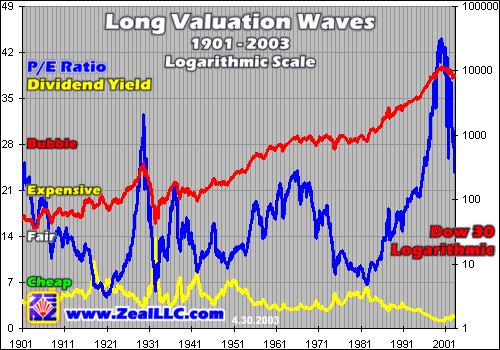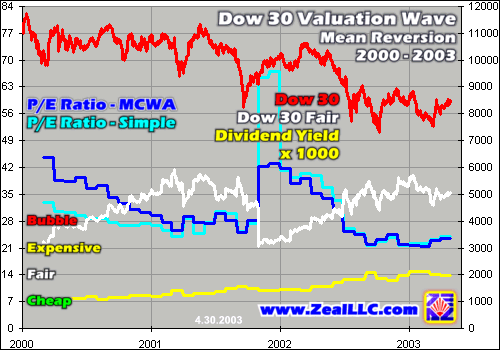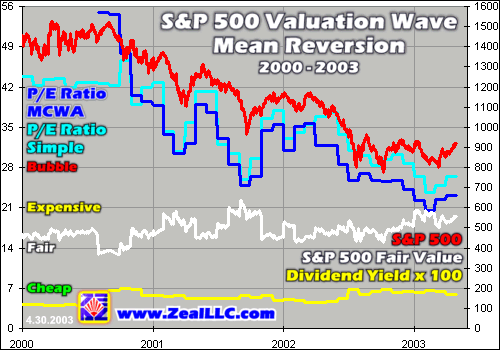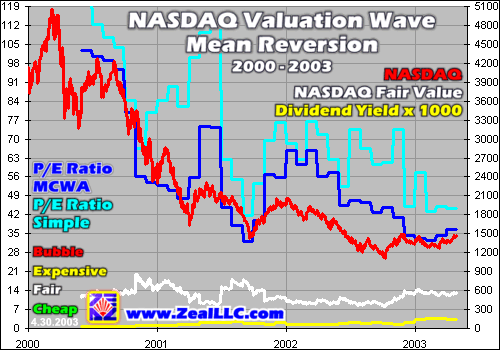|
|
|||||||
|
|
|
|
|
|
|
|
|
|
Valuation Wave Reversion 2 Adam Hamilton May 30, 2003 3774 Words
While the popular dueling emotions of greed and fear drive tactical short-term stock-market movements, over the strategic long-term there is no more important or more potent force driving the markets than valuation.
Valuation is simply the cost of an individual stock or an entire stock index as a whole relative to its actual earnings and dividends at any given moment in time.
Stocks are not merely lottery tickets or abstract pieces of paper, they are fractional ownership stakes in real living and breathing corporations. A share of stock grants investors a fractional ownership right to participate in the future earnings and dividends streams actually spun off by a company in its real-world business operations.
As such, when an investor wishes to buy a stock it is very important to know how many pennies of earnings he is purchasing for each dollar of his scarce capital. Will a dollar invested in a company buy 20 cents of annual earnings or 2 cents? The more that it costs investors for each penny of earnings they are purchasing, the higher the valuation of a given stock or stock index.
Obviously it is far better to buy low and sell high than to buy high and hope to sell higher! Prudent long-term contrarian investors seek to buy at low valuations and sell at high valuations, not to buy at already high valuations and merely hope for even more extreme valuations!
Humorously, this buying-high-and-hoping-to-sell-higher school of investing that is so popular today has long been known as the “Greater Fool Theory”. Someone who buys an expensive stock at high valuations is a fool, and the only way they can sell for a realized profit later is if they manage to find an even greater fool in the future to which to sell their overpriced shares!
The more earnings that shareholders can buy for each of their dollars, the lower the valuation of the stock they are purchasing. Centuries of market history have unarguably proven that the ultimate way to excel at investing is to buy stocks cheap, at low valuations when a dollar buys lots of earnings, and sell them dear, at high valuations when a dollar doesn’t buy much earnings.
Valuation is a complex subject and there is certainly a lot of important prerequisite background information about it that must be understood. I have written about valuation in much greater depth in “Long Valuation Waves”, my original “Valuation Wave Reversion” essay, and “Dividend Valuation Waves” if you haven’t studied this fascinating concept recently.
It is absolutely crucial that both investors and speculators always maintain a general understanding of the current state of general valuations in the US equity markets. Valuation is the ultimate driver of long-term stock-market trends, so a working knowledge of existing valuation fundamentals at any given time is essential for discerning the potential duration and extent of the current long-term trend driving the stock markets.
This week I would like to zoom back out from the tactical short-term sentiment arena that we have been intensely focusing on in recent months and once again discuss strategic long-term valuations. Specifically this essay is an update on the current state of the massive Long Valuation Waves driving the US stock markets and their already-in-progress powerful mean reversion.
Some folks, particularly gunslinging short-term speculators, tend to ignore valuation and believe it is an irrelevant academic concept. I strongly disagree, however, because a working knowledge of current valuation fundamentals is just as essential for short-term speculators as it is for long-term investors. A speculator who is unaware of current valuation fundamentals may have a difficult time understanding the long-term trends in force.
Since the war rally erupted in mid-March, the legions of perma-bulls along with the eternal Wall Street optimists have been trying to win investors’ and speculators’ hearts and minds with their curious notion that the Great Bear is dead and a brand new bull market has been miraculously reborn from the ashes. Does this theory have merit or is it just more-of-the-same meaningless bullish propaganda like we have heard for over three years of brutal bear markets now?
Interestingly, a working knowledge on the current state of valuation and the Long Valuation Wave mean reversion in US equities sheds much needed light on the viability of the brand-new-bull hypothesis. Hundreds of billions of dollars will be won and lost based on whether we have just witnessed an uninspiring garden-variety bear-market rally in recent months or the spectacular birth of a new bull. You don’t want to be on the wrong side of this macro trade!
In order to investigate the potential that we are witnessing the end of the Great Bear and the glorious birth of a new bull market, we first need to understand Long Valuation Waves in history and then apply this knowledge to the current stage of the US markets within these Long Valuation Waves.
Our first graph this week is an update from “Long Valuation Waves” that shows the venerable Dow Jones Industrial Average graphed over the general price-to-earnings ratio and dividend yield of the US stock markets for the last century or so. We use the Dow 30 as our visual stock-market proxy since it is the most well-known stock index in history. The accompanying valuation data in this first graph, however, is actually from the S&P Composite so it reflects the markets as a whole and not just the narrow Dow 30.
The general market P/E ratio and dividend yield for every month last century are graphed on the left axis. The historical average US equity P/E ratio of 14x earnings is considered fair value, one half that at 7x is considered cheap and undervalued, and twice that at 28x earnings is hyper-overvalued bubble territory. As you will see below, future stock-market performance is awesome when the markets are undervalued and horrible when the markets are overvalued. Valuation matters.
If you would like some more background information on why 14x earnings is considered fair value throughout history, there is an extensive discussion on this very issue in “Long Valuation Waves”. This earlier essay also offers more technical information on this extraordinarily important graph.
The fabled Long Valuation Waves are represented by the blue P/E-ratio line above. It even looks like the cross section of a great undulating wave rolling across the open ocean!
The stock markets perpetually oscillate in great multi-decade cycles through history, the Long Valuation Waves. The markets start out very cheap at low valuations around 7x earnings, and then stock prices are gradually bid up over a decade or more until they are overvalued above 21x earnings. Then the markets either fall sharply or trade sideways for a decade or two and ultimately arrive at low valuations once again, and this endless cycle begins anew like a phoenix.
The whole 20th century is a perfect example of this immensely powerful phenomenon. In the early 1900s the stock markets were expensive, trading at over 21x earnings, and the Long Valuation Wave was ebbing back down towards another long-term trough. While valuations retreated from unsustainable highs, the Dow 30 essentially traded sideways until 1915 when corporate earnings finally caught up with stock prices and drove valuations under fair value once again.
Then in the early 1920s valuations reached dismal lows under 7x earnings and the second-greatest bull market of last century violently erupted out of the ashes. In the Roaring 20s the stock markets exploded up to staggering heights in a vertical bubble blow-off and valuations soared above 28x bubble-valuation levels. The ultimate result of these extreme overvaluations was the necessary corrective bust period of the 1930s, the terrible Great Depression era.
After the gross valuation excesses of the late 1920s, the stock markets essentially traded sideways again as valuations gradually fell until the Second World War. Then, once again from the ashes of terribly undervalued levels, the third-greatest bull market of the 20th century began galloping. It soared for almost two decades in the 1950s and 60s and ultimately carried the Dow 30 from around 100 to almost 1000.
But, after this bullish segment of the Long Valuation Waves, valuations were once again too high above 21x earnings and an adjustment had to be made. So for the next 15 years or so the US stock markets again traded sideways as general valuations gradually ground back down to historically undervalued levels around 7x earnings in the early 1980s. Yet again corporate earnings had to spend many years catching up with the overvalued stock prices of the late 1960s.
From these ultra-undervalued levels, in 1982 the greatest bull market of last century, and indeed probably of many centuries, erupted out of the ashes of despair and propelled the Dow 30 from well under 1000 to over 11000 in almost two decades. As a result of this Great Bull, the Long Valuation Waves were stretched up to previously unthinkable extremes above 42x earnings, as is evident above. The staggering valuation heights reached by the general markets in 2000 were absolutely unprecedented.
And as is painfully obvious today, since those euphoric days of mania notoriety in 2000, both the US stock markets and the Long Valuation Waves have been falling, with valuations rapidly mean-reverting back down towards their historical 14x long-term average.
If there is one grand strategic message from the markets of the 20th century, it is the phenomenal importance of current valuation levels for long-term performance. If you carefully examine the chart above, you will note that the future performance of the stock markets was extremely dependent on current valuations.
Every time that general-market valuations approached the expensive level, over 21x earnings, the years and decades following this valuation extreme inevitably witness either a large bear market or at best a grueling sideways-trading market for decades! An investor or even a speculator who bought stocks near long-term high valuation extremes was doomed to either poor or negative returns for many years into the future.
But on the other side of the coin, any investor or speculator who was wise enough to buy stocks when they were undervalued at a Long Valuation Wave trough was blessed to receive absolutely awesome double-digit returns in the following years as the upwards Long Valuation Wave mean reversion ensued. Each of the three greatest bull markets of the last century, the 1920s, the 1950s and 60s, and the 1980s and 90s launched when the US equity markets were absolutely undervalued by historical standards near very low P/E ratios around 7x earnings.
These Long Valuation Waves graphically reveal the very essence of successful contrarian investing, buying low at undervalued levels and selling high at overvalued levels! Valuation matters, and ignoring it is a recipe for disaster.
In light of evidence as powerful as this, how can anyone even consider buying overvalued stocks for long-term investing purposes? Yet, ever since 2000, Wall Street has been utterly ignoring the Long Valuation Waves and nefariously seducing investors into buying overvalued stocks, and they have already lost trillions by following this horribly flawed and negligent advice.
Whether or not the recent war rally is merely a typical sharp bear-market rally or something special, the beginning of a new bull market, largely depends on the current state of the Long Valuation Waves. As you can see above, the Long Valuation Waves have already plunged from over 42x earnings to back under 28x earnings, but they still have a long way down to go yet to reach historically undervalued levels around 7x earnings.
The Long Valuation Waves ominously declare that the Great Bear is only about half over so far! Yikes.
The initial start of the mean reversion of these Long Valuation Waves in 2000 is very evident above, but we can glean even more insights into the fundamental health and future prospects of the markets by zooming into just the post-1999 mean-reversion portion of these Long Valuation Waves. Our next three graphs highlight the mean-reversion years in the Dow 30, S&P 500, and NASDAQ and offer priceless insights into the viability of the inherently flawed new-bull-market-today hypothesis.
The Dow 30 Great Bear market has been much less painful than the S&P 500 or NASDAQ action, but the returns for investors over the past three years in the Dow have still been atrocious. The Dow-30-specific P/E ratio has fallen from above 42x down to 21x in the past few years, but this elite index is still nowhere close to being formally undervalued around 7x.
The war rally erupted with the Dow 30 still trading at historically expensive levels above 21x earnings. In light of the history of the Long Valuation Waves what are the odds that a new bull market can launch from such lofty overvalued heights? Pretty darned low!
Investors buying the Dow 30 today because they are believing Wall Street’s incessant lies that “stocks are cheap” are being bamboozled and will ultimately lose a lot of capital. The Long Valuation Wave mean reversion has begun, but like the Long Valuation Waves all throughout history probabilities suggest that this mean reversion won’t end until the Dow 30 is ultimately undervalued way down near 7x earnings.
You are probably wondering why there are two separate P/E ratio lines in the graph above. The first dark-blue one is the market-capitalization-weighted-average P/E ratio, which is my personal favorite. MCWA P/Es prevent small companies with crazy valuations from unduly skewing the overall P/E for an entire index as a whole. An individual component’s P/E ratio is only weighed in proportion to the size of the company itself. MCWA P/Es for indices are much more conservative and realistic over the long-term.
The light blue line is the usual simple average P/E ratio of the index, obtained by adding up the P/Es of each of the individual Dow 30 component companies and dividing by 30. We included this line to enable us to see the differences over time between our preferred MCWA P/Es and the standard simple-average P/Es. For a more extensive discussion on the differences between these two index-P/E-calculation methodologies, please check out www.zealllc.com/faq/page3.htm on our website.
If we consider the current MCWA P/E of the Dow 30 compared with its historical average P/E of 14x earnings, we can also gain an idea about what the approximate fair value for the index has been in recent years. The white line above records these adjusted index prices that represent a Dow 30 trading at 14x earnings at any given time. Today this elite index is only worth about 5000 based on average historical valuations, so the Long Valuation Wave mean reversion almost certainly still has a lot of work left to do yet.
In addition to using P/E ratios alone as our prime valuation metric for watching the unfolding progress of the Long Valuation Wave mean reversion, dividend yields can also be used. I discussed this in more depth in “Dividend Valuation Waves” about five months ago. As the yellow Dow 30 dividend yield line above shows, the Dow 30 was only yielding about 2% in dividends when the war rally erupted.
A 2% dividend yield is the mark of a very expensive market, not a cheap one! Dividend yields are still near all-time lows and will have to march much higher before the Long Valuation Wave mean reversion fully runs its course. The long-term average dividend yield for the US markets is around 4.6%, so the Dow 30 won’t even hit fair value, let alone undervalued levels, until its component companies manage to dramatically increase their cash dividend payouts. And unlike earnings, cash dividends can not be faked!
Any way you want to slice it, the Dow 30 is still tremendously overvalued and the Long Valuation Wave mean reversion has a long way to go yet until valuations once again hit undervalued levels. A new bull market being born under these hostile conditions is practically impossible, which reveals the inherent foolishness in believing in the new-bull-market thesis today. If new bull markets in history don’t launch from valuations over 21x earnings, why should today suddenly be special and throw out all the ancient laws of finance?
Our final two graphs are built on the same valuation methodology, but apply to the flagship S&P 500 index and the hyper-speculative but still popular NASDAQ casino. These indices are in even worse shape today than the Dow 30 in valuation terms, and the Long Valuation Wave mean reversion will probably ultimately be much more brutal in these broad indices than in the narrow blue-chip Dow.
The S&P 500, largely because it was dominated by the huge mega-tech companies in 2000, reached much higher valuations than the conservative blue-chip Dow 30 at its bubble top. Fair value for this index is currently running around 550 or so, which is vastly lower than today’s lofty war-rally levels. The S&P 500 is also yielding under 2% in dividends, farther cementing its infamy as a grossly overvalued index even today after three years of a vicious Great Bear market.
Market history strongly suggests, either by continued falling or sideways trading for a decade or more, that the S&P 500 Long Valuation Wave mean reversion will not end until its P/E is well under 14x earnings and its dividend yield is well over 4.6%. Just as in all the rest of history, investors who buy the major US stocks today at such grossly overvalued levels are almost certainly dooming themselves to low or more likely negative returns for many years to come. The greater fools are out in force these days thanks to the fleeting sentiment-driven war rally!
And finally we arrive at the NASDAQ, the Mother of All Bubbles. The P/E ratios and dividend yields shown here are actually those of the NASDAQ 100, as these 100 largest stocks in the NASDAQ Composite index utterly dominate its total market capitalization. The NASDAQ Long Valuation Wave mean reversion has indeed already been horrific, but with current valuations today it isn’t even close to being done yet! Read it and weep.
Fair value for the NASDAQ based on the current earnings power of its component companies is still hovering under 600! An incredible number of daring speculators have piled on board the NASDAQ since its pre-war interim lows in March. They are making a huge gamble that for the first time in history the Long Valuation Wave mean reversion will miraculously stop while valuations formally remain deep in stellar bubble territory.
Watching recent NASDAQ action is like witnessing the early 2000 bubble mania all over again. As you no doubt remember, back in early 2000 the tech zealots tried to convince the world that earnings, dividends, and valuations were suddenly meaningless thanks to a Brave New Era. They were certainly right that the Information Age is exciting, but they were dead wrong that investors were willing to forever foolishly invest in hyper-overvalued companies that couldn’t provide fair and reasonable returns on investors’ scarce capital.
With Long Valuation Waves, it is important to remember that they oscillate around fair-value valuations, both above and below fair value. This means that during post-bubble downward-falling wave faces like we have witnessed in the US markets in recent years that valuations will almost certainly overshoot fair value and head deep into undervalued territory under 14x earnings.
If the white fair-value levels above of the Dow 30, S&P 500, and NASDAQ indices based on their current earnings power today look low to you, try to imagine them at truly undervalued levels around half fair value! The consequences of the Great Bear continuing to maul the Big Three indices back down to these abysmal depths will be staggering, yet sadly this is exactly what history suggests will happen before the end of this bust.
Busts aren’t supposed to be fun and they don’t end in history until most of a whole generation swears to never invest in stocks again. Busts don’t end until the vast majority has completely given up on even looking for The Bottom! Total, unconditional popular surrender and capitulation is required.
Today’s investors and speculators buying the war rally for any trade that is expected to last more than a month or two are spitting in the face of history, probability, and valuation and they will probably be mercilessly crushed for brazenly ignoring the long-term rules of the game.
If you are as fascinated as I am in watching the Long Valuation Wave mean reversion continue to unfold each month, you may be interested in subscribing to our acclaimed Zeal Intelligence newsletter. Every month we painstakingly calculate all the individual component-company valuation data for the Dow 30, S&P 500, and NASDAQ and compute the current month-end MCWA P/E ratios and dividend yields for these elite indices.
This exercise helps ensure that we and our clients won’t make the lethal mistake of falsely believing that the Great Bear is over before the normal Long Valuation Wave mean-reversion process finally ends at historically undervalued levels. We are going to throw long the US equity markets in a big way in the future, but as zealous contrarians we will not commit our capital until valuations are near historic lows and we have an extremely high probability of reaping legendary returns off of the coming historical Long Valuation Wave trough.
In light of the current ominous Long Valuation Wave mean-reversion situation, the probability that the Wall Street perma-bulls are right about a new bull market being born in mid-March is so low as to be laughable. For all of market history markets have oscillated between overvalued and undervalued levels and back again. Yet, for unexplained reasons, the perma-bulls today are dangerously trying to convince everyone that “This Time It Is Different” and the laws of finance no longer apply in this Brave New Era. Poppycock!
“This Time It Is Different” are the five most dangerous words any investor can ever utter. Nothing fundamental ever changes in investing and speculating! It is inconceivable that the Great Bear is dead and a new bull has been born with rampant overvaluation still everywhere today.
Today’s war-rally optimists hoping for a new bull will pay a heavy price for ignoring history and scoffing at the Long Valuation Waves.
Adam Hamilton, CPA May 30, 2003 Subscribe |
|||||||
|
|
|
|
|
|
|
|
|
|
|
|
|
|
|
|||




